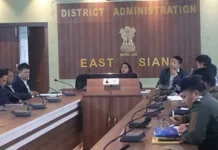Monday Musing
[ Amar Sangno ]
Every legislator who rose to speak on the floor of the House during the recently concluded Legislative Assembly sessions decried the prevailing education scenario in the state. The subject of education was the focal issue and took centrestage.
Their impassioned speeches, emphasising the need for effective transformation of the state’s education system, were met with either silent nods of agreement or rapturous applause from colleagues across party lines, indicating that each one of them had deep concerns.
Were our lawmakers really serious about the education scenario, or were their speeches mere rhetoric? This is the million-dollar question that the common people should throw on the face of all legislators. Truth be told, many close relatives or kith and kin of legislators are teachers only on paper and in government records, but have never taught a class since their relative became an MLA. Some are attached to non-teaching departments, draining human resources and causing scarcity of subject teachers in the schools.
There was a lack of energy and intensity among the legislators when Education Minister Pasang Dorjee Sona sought their assurance not to interfere with the teachers’ transfer and posting policy. Perhaps their grand perorations were mere rhetoric when it came to their own homes.
Let’s not be cynical here. Charity should begin at home. In the five-day session, the topic of education was dominant almost in three sessions, insinuating that it’s a ‘now or never’ situation for both the education department and its minister to set things in order.
There are notable faultlines in the education system, which have resulted in the abysmal performance and lack of quality education in the government-run schools. The rationalisation of teachers’ transfer and posting has taken a beating and never saw the light of day, despite a policy having been framed in 2015.
In the policy, there are three categories of postings: hard belt, middle belt, and soft belt. Teachers who have better political connections are never posted in hard-belt areas throughout their service length. Specifically, non-APST teachers working under the Integrated Scheme for School Education (Samagra Shiksha/ISSE) are soft targets for exploitation.
“Good and sincere teachers are being victimised and harassed. Many of us have been serving at same posting place for the last 15 years. The teachers’ transfer and posting system is politicised right from the grassroots level,” lamented a PRT, speaking on the condition of anonymity.
“I cannot spend my entire service life in an interior place (hard-belt area). I have kids to raise and to provide them with better educational facilities. The government should provide extra incentives to teachers posted in hard-belt areas, similar to those in the defence services. Otherwise, why should I bear the burden of state education?” said another PRT angrily, adding that the rules are made or framed only to exploit weaker and sincere teachers.
“Apart from political interference, a surplus number of female teachers is one of the major glitches in the ineffective rationalisation of teachers’ transfer and posting policy,” observed Seppa (E/Kameng) BEO Ashing Lamgu.
According to Lamgu, all female teachers are either posted in schools in the district headquarters or in the Itanagar Capital Region. “Except in exceptional cases, such as joint posting with their husbands, no female teacher is ever posted in hard-belt areas,” he added.
Lamgu claimed also that many schools in the ICR have a surplus of teachers, exceeding the average pupil-teacher ratio (PTR) of 1:35.
Flawed policies, such as the random opening of schools in less populated villages, have resulted in zero or low enrolment. Many schools were opened at the whim of short-sighted political leaders and SMC chairpersons.
The education minister himself informed the House that the state government has shut down around 600 schools that were either non-functional or had zero enrolment.
When asked, Sona said that the focus is more on the elementary level, aiming to create better infrastructure with adequate human resources;rationalise teaching and non-teaching staffs; develop a new curriculum with numerous digital interventions to make studying more engaging; and organise a conclave to understand the challenges and solutions.
He informed also that schools with zero or low enrolment would be closed down to prevent resources from being wasted. To ensure effective implementation of the rationalisation of teachers’ transfer and posting, a session will be called with all ministers, MLAs and ZPCs to find a solution, he said.
Needless to say, the department requires concerted efforts and pragmatic approaches to address the issues. Unless a rotational system is introduced, allocating two years for female teachers and five years for male PRTs in hard-belt or middle belt, the rationalisation of transfers and postings will never materialise.
Hopefully, the recruitment of 500 teachers, which is pending with the Arunachal Pradesh Public Service Commission, will help alleviate the shortage of teachers and revamp the education department. It is now time to act. As Chief Minister Pema Khandu often says: “Yehi samay hai, sahi samay hai,” which loosely translates to: This is the right time, this is the right moment.



